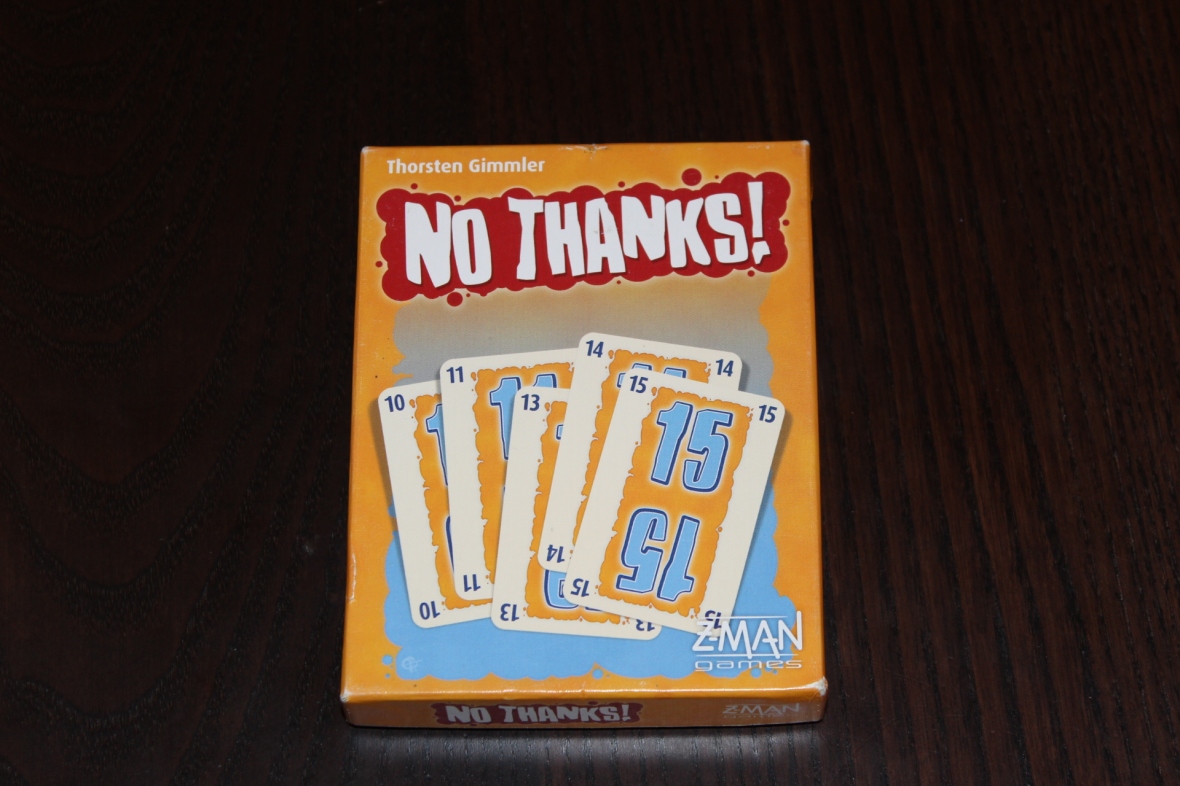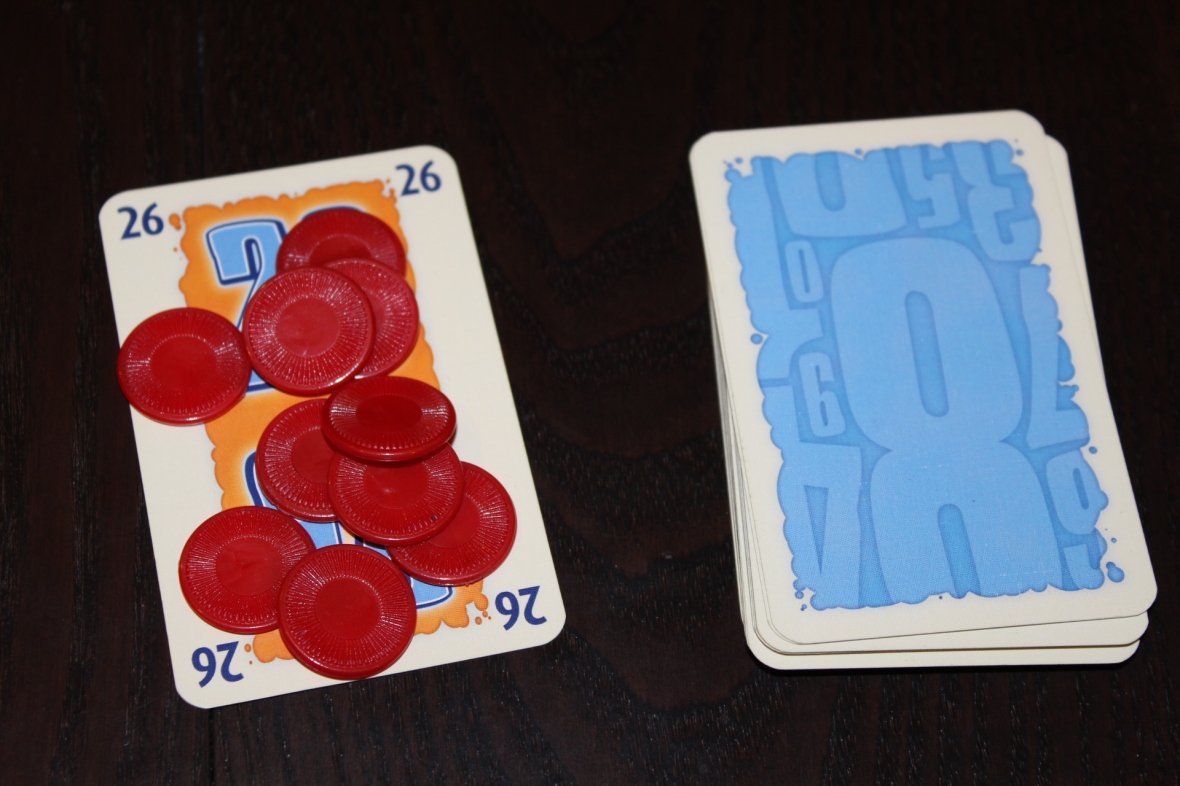 Base price: $10 – $13.
Base price: $10 – $13.
3-5 players
Play time: 15-20 minutes
BGG Link
Buy on Amazon (via What’s Eric Playing?)
Apparently there’s a new version of this on Amazon as well, also by Mayfair. Did Z-Man games go under or something? It’s Saboteur all over again. Weird.
Anyways. No Thanks! is a quick little game about scoring points, or, rather, politely declining the opportunity to score points. This is not going to be a particularly lengthy review.
Contents
Setup
So, you’ll notice in the bag that you’ve got cards numbered 3 – 35 and 55 red chips. Give each player 11 chips, and shuffle the deck of cards. Set nine of those cards aside, without looking at them — you won’t need them for the game. See? Easy. Let’s move to Gameplay.
Gameplay
This is dead simple. Start by choosing who goes first (I always recommend Chwazi, king of apps), and flip a card off the top of the deck. Now, you can either take the card and add it to your score area or spend one of your chips and say, “No Thanks.”, like so:

Or, more commonly, this:

Play passes to the player on your left. This continues until someone has taken the card (as someone must, eventually, because everyone will run out of chips).
Now, you might be wondering why you don’t just take every card that you’re given. Well, as you might guess, you want as few points as possible. Like golf, the winner is the player with the lowest score, and any leftover chips you have are worth -1 point each at the game’s end (when the deck is depleted). This means chips are quite valuable.
But that’s not all! There is also the concept of a run, in which you have two or more consecutive cards in your score pile (such as 30 and 31, for instance, or 15, 16, 17, and 18). In this case, the total run’s value is the lowest card in the run. So, for those of you keeping score at home, if you have the cards 30, 31, 32, 33, 34, and 35 in your pile, rather than having 195 points (you would lose), you actually only have 30 points. This is quite nice. However, if you have 30, 31, 32, 34, and 35 (no 33), you have 64 points (30 + 34). You might note that I mentioned to remove nine cards from the game earlier — you’re never TOTALLY sure that you’re going to get the cards you need for your run.
As you might imagine, there’s some strategy to this.
Strategy
- One of the primary strategies is something we call “milking”, in which you don’t take a card because you know everyone else wants it less. For instance, if you have the 34 and the 35 comes up (highest-scoring card in the game), it’s worth 0 to you, so you might as well take it. But if you don’t take it, either someone else has to (and since you have the 34, there’s no way they can get a run off of it), or they have to give you a ton of their chips (even better!). It’s a robust strategy.
- Splitting other people’s runs is an … okay strategy. I mean, if someone’s about to link their 15-16-17-18-19 run to their 21-22-23-24-25 run (somehow), it might be worth taking the 20 yourself, yeah, but that’s usually pretty uncommon.
- Do not take every card. You might think it’s a good idea because you have the best chance of getting runs, but, turns out, taking zero cards is a pretty great strategy too. It’s just normally not viable.
- Never run out of chips. This is how people get devastated in this game. They run out of chips and then they have to take many, many high-point cards without being able to make a run out of them. This is pretty much the equivalent of getting eliminated, because you’re taking like 16, 25, and 33 and maybe 5 chips. You do not win that way.
- Try to keep some idea of how many chips everyone else has. Don’t count chips (that’s crappy), but try not to send the card you’re milking to someone who has zero chips, forcing them to take it and split your run. That’s … not smart.
- Do not let other people know how many (or few) chips you have. This should be obvious, but, yeah. That lets them kind of screw you over by forcing you to take high-value cards or block you from getting a bunch of chips by taking the card first. Usually, the only good time to reveal you were out of chips is when you take a lot of them.
- It’s not bad to have a “number”. What I mean by this is that chips effectively reduce the value of the card you’re picking up, and it’s good to have a threshold at which you’ll take the card. It keeps you a bit consistent. I have one, but I know some of my friends read my blog so I’m keeping my number to myself.
Pros, Mehs, and Cons
Pros
- Short and light, but with some strategy. As is becoming a regular thing, I prefer games that you can play multiple times in one night, and this is no exception.
- Simple. You could very easily teach this to kids, no sweat.
- Portable. This is the same size as Hanabi and Saboteur, so it’s great to tuck in a bag or a backpack before you go somewhere.
- Pretty fun, actually. There’s definitely some yelling and mild rage when someone flips over the last card they need to complete their ten-card run, but that’s the name of the game. It’s too short to get that angry over.
Mehs
- None, really. It doesn’t really have that much content, so it’s hard to be very meh on anything.
Cons
- Really just, no art or theme to speak of. It’s a bit disappointing.
Overall: 7.5 / 10

I tend to play this a bit more than Saboteur, for instance, and that’s just because it’s a bit shorter and a bit less random, in my mind. Sure, there’s some luck to what cards aren’t in the game, but usually you can mitigate that with a good strategy. There’s not a TON to write home about (or even, honestly, write about — I’ll barely make 1000 words on this, if I even get that far), but it’s solid for what it does. If you’re looking for a quick, light, fun game for your group, you should probably say, “No Thanks!”
By which, I mean, you should get this game. I suppose that’s a bit ambiguous.